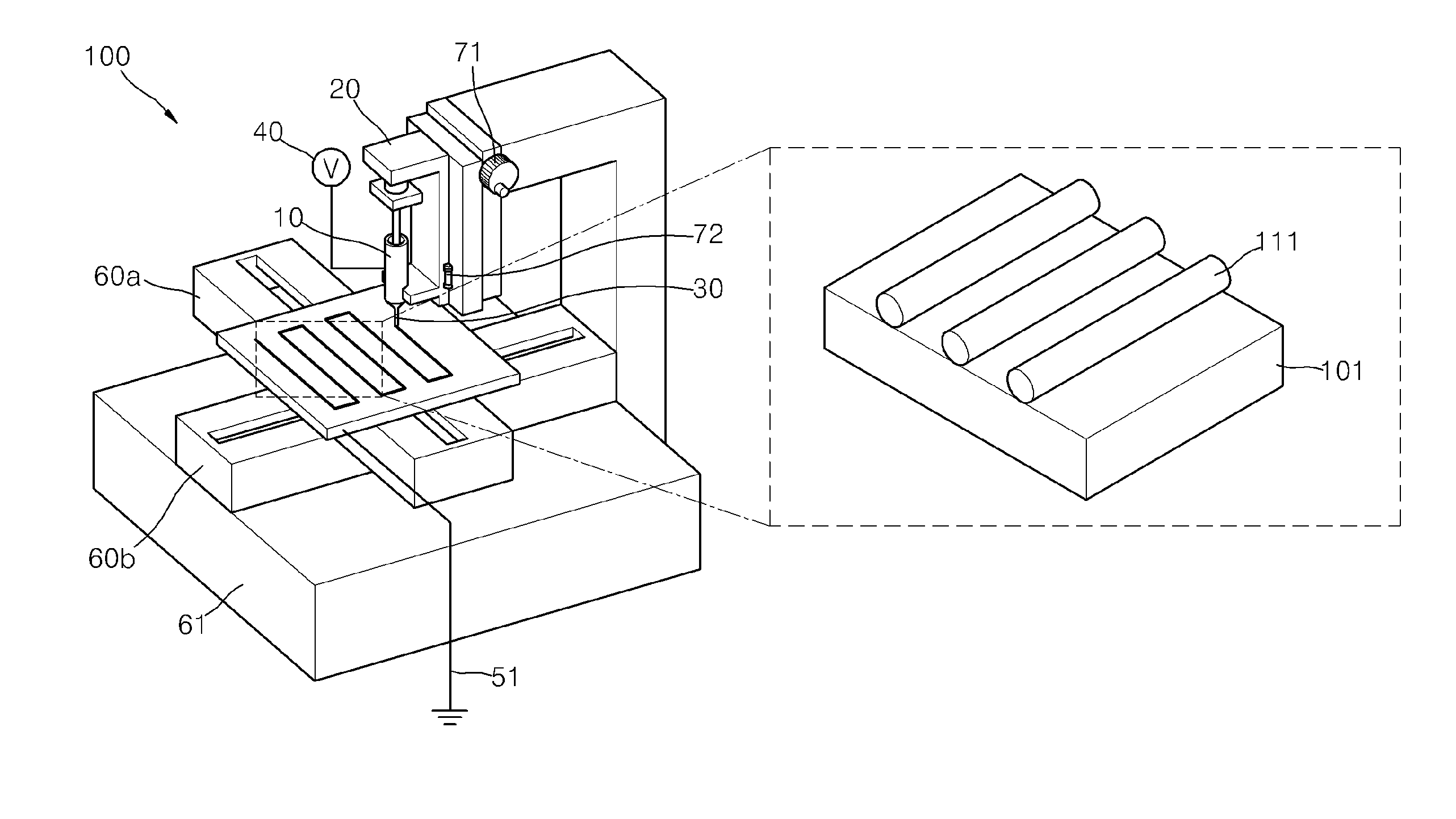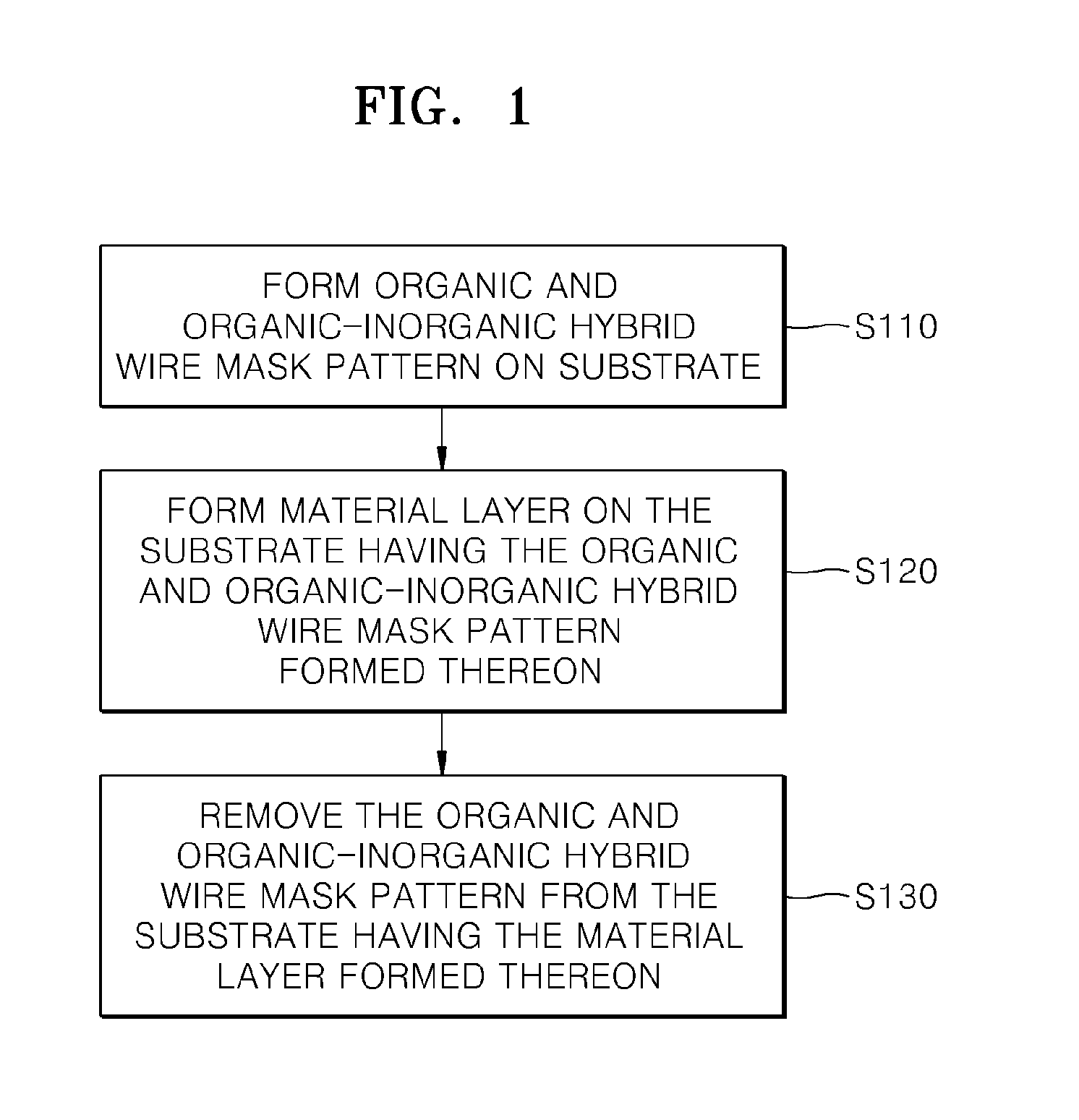Micro-Pattern Forming Method, and Micro-Channel Transistor and Micro-Channel Light-Emitting Transistor Forming Method Using Same
a technology of micro-patterns and transistors, applied in the field of micro-pattern forming methods, can solve the problems of large amount of time and cost, complicated process, and expensive equipment using deep ultraviolet (uv) with expensive parts, and achieves high luminous efficiency, facilitates injection of holes and electrons, and high cost
- Summary
- Abstract
- Description
- Claims
- Application Information
AI Technical Summary
Benefits of technology
Problems solved by technology
Method used
Image
Examples
example 1
[0113]A pattern having a nanospacing formed of gold (Au) was prepared by using the method of forming a micropattern according to the embodiment of the present invention.
[0114]First, a nanowire mask pattern formed of a polymer material was formed on a substrate. In detail, poly(N-vinylcarbazole) (PVK) was first dissolved in styrene to prepare a PVK solution. The PVK solution was put in a syringe of an electric field aided robotic nozzle printer and the PVK solution was discharged from a nozzle while a voltage was applied to the nozzle. A PVK nanowire mask pattern was formed on the substrate on a collector moved by a robot stage.
[0115]At this time, a diameter of the nozzle used was 100 μm, a distance between the nozzle and the collector was 2.5 mm, an applied voltage was 4 kV, and a discharge speed of a solution was 500 nl / min. A movement spacing in a y-axis direction of the robot stage was 50 μm and a movement distance in an x-axis direction was 15 cm. A movement speed in the y-axis ...
example 2
[0120]A square pattern formed of gold having a nanospacing was prepared by using the method of forming a micropattern according to the embodiment of the present invention.
[0121]First, an orthogonal pattern composed of polymer nanowire mask patterns having a width of about 460 nm and a spacing of about 50 μm was prepared on a substrate. The polymer nanowire mask pattern was formed of PVK. In detail, as described in Example 1, PVK was first dissolved in styrene to prepare a PVK solution. The PVK solution was put in a syringe of an electric field aided robotic nozzle printer and the PVK solution was discharged from a nozzle while a voltage of 4 kV was applied to the nozzle. A robot stage was moved in an x-axis direction to form a nanowire mask pattern in the x-axis direction and the robot stage was moved in a y-axis direction to form a nanowire mask pattern in the y-axis direction, and thus a nanowire mask orthogonal pattern was formed.
[0122]At this time, a diameter of the nozzle used ...
example 3
[0126]A nanochannel thin film transistor was fabricated by using the method of forming a micropattern according to the embodiment of the present invention.
[0127]A titanium (Ti) gate electrode having a width of 600 μm and a thickness of 30 nm was formed on a silicon wafer. An aluminum oxide (Al2O3) gate dielectric layer having a thickness of 50 nm was formed on the gate electrode by atomic layer deposition. Gold electrodes having a spacing of 340 nm and a thickness of 70 nm were formed on the gate dielectric layer as source and drain electrodes.
[0128]First, a nanowire mask pattern having a diameter of about 350 nm and a spacing of about 5.5 mm was formed on a substrate having the Ti gate electrode and the Al2O3 gate dielectric layer formed thereon in order to form the gold electrodes having a nanospacing. The nanowire mask pattern was formed of PVK.
[0129]In detail, as described in Example 1, PVK was first dissolved in styrene to prepare a PVK solution. The PVK solution was put in a s...
PUM
 Login to View More
Login to View More Abstract
Description
Claims
Application Information
 Login to View More
Login to View More - R&D
- Intellectual Property
- Life Sciences
- Materials
- Tech Scout
- Unparalleled Data Quality
- Higher Quality Content
- 60% Fewer Hallucinations
Browse by: Latest US Patents, China's latest patents, Technical Efficacy Thesaurus, Application Domain, Technology Topic, Popular Technical Reports.
© 2025 PatSnap. All rights reserved.Legal|Privacy policy|Modern Slavery Act Transparency Statement|Sitemap|About US| Contact US: help@patsnap.com



